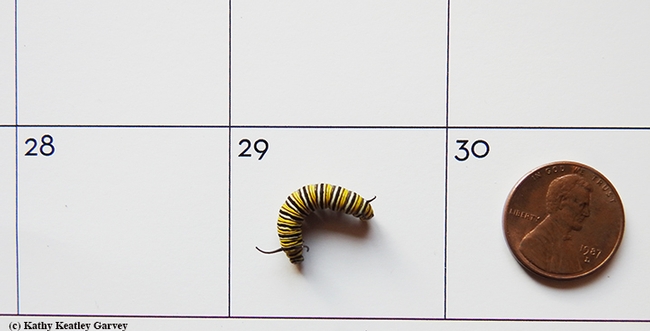- Author: Kathy Keatley Garvey

The predators? They include lady beetles (aka ladybugs), spiders, milkweed bugs, assassin bugs, wasps and birds. Parasitoids? The major ones here in our family's pollinator garden in Vacaville are the tachinid flies. They lay their eggs in or on your caterpillars or on the leaves where your caterpillars will be feeding. The tachinid eggs hatch and develop into larvae that will eat your host from the inside out. (We like tachinid flies when they lay eggs in such pests as tomato hornworms or cabbage loopers.)
So we have these magical, miraculous monarch moments in our indoor nursery (the kitchen counter) and I'm sort of the midwife who lends a helping hand. The 15 eggs I collected have hatched and are now second or third-instars. Monarchs go through five instars before they pupate.
When the egg hatches, the caterpillar is a first instar. It's a pale gray, light green or transparent, and is easily distinguishable by its black head. The first thing it does is eat its eggshell. Then it starts devouring milkweed.
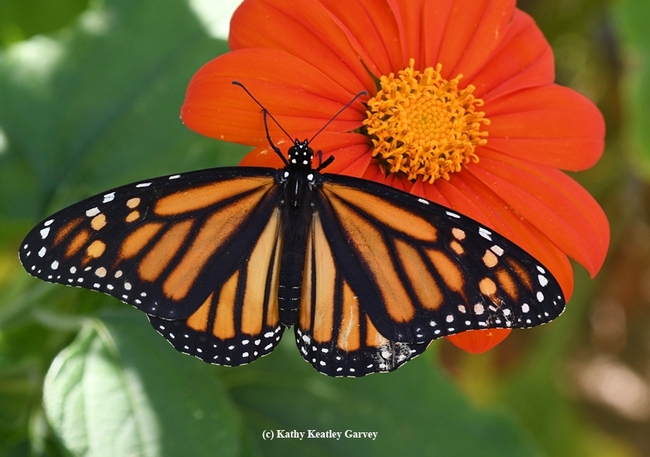
With the third instar, the caterpillar coloring is darker and more distinct. "The third (and later) instars respond to disturbance by dropping off the leaf and curling into a tight ball," according to Monarch Joint Adventure. "Monarch biologist Fred Urquhart called this behavior playing possum."
Some of our tiny 'cats are still in those lidded salsa container cups, with a "floor" of a damp tissue to keep the fresh leaf from drying out. This is how naturalist Greg Kareofelas, associate of the Bohart Museum of Entomology, UC Davis, does it. (See Bug Squad blog). He inserts one 'cat per container. And it's important to change the leaves and empty the frass (droppings) at least once, preferably twice a day. The 'cats can skeletonize the leaves quickly. (Like ravenous teen-agers, they'll eat more than you think they will!)
When the 'cats become third-instars, like graduating from the first grade to the third grade, we change their environment. Out of the lidded containers they go, and onto leaves tucked into water-filled floral tubes. We place the tubes inside a netted, zippered butterfly habitat container, like the ones that the Bohart Museum of Entomology at UC Davis (temporarily closed due to the COVID-19 pandemic) sells. If the caterpillars are not confined, they will wander away to pupate--perhaps on your cell phone cord as one of ours, an Indiana Jones or Indiana Joan, did.
Usually we raise monarchs from caterpillars, not eggs, because the 'cats are easier to detect. (This Bug Squad blog offers some of our "monarch starting kit" tips. Key to the starting kit is a heavy, flat-bottomed, narrow-necked tequila bottle.)
Meanwhile, the 15 'cats are doing what 'cats do--they are eating. They're safe and sound and out of reach of the predators and parasitoids and other threats that could kill them.
Once the adults are released into the neighborhood, though, they are fair game for birds, praying mantids and the like. Maybe some monarchs from our magical, miraculous monarch nursery will make it to the overwintering sites along coastal California and the cycle will begin again.
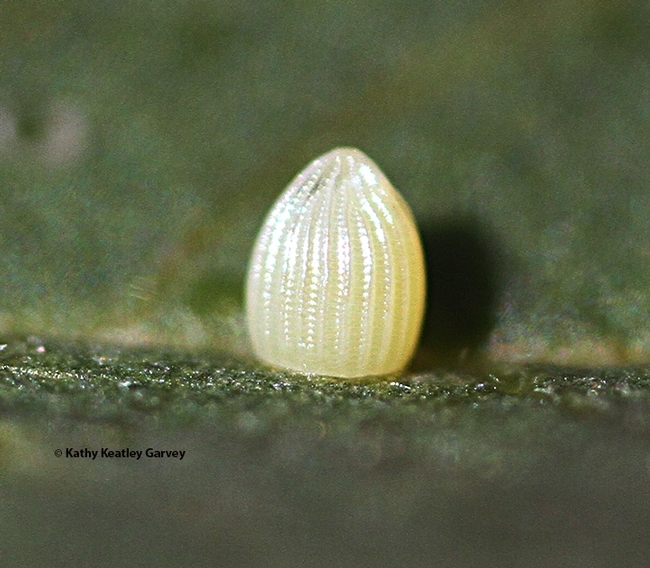
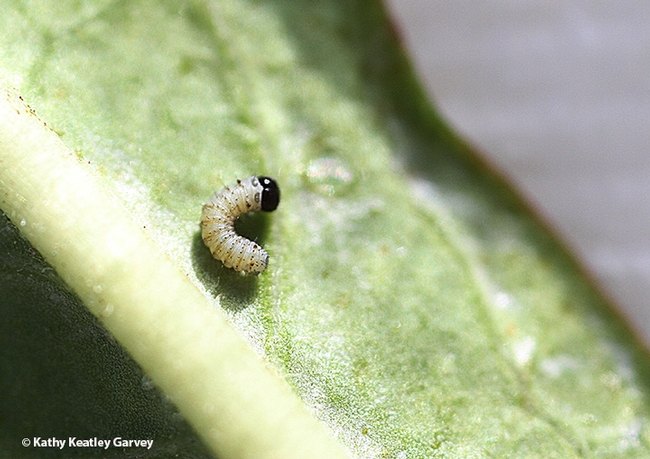
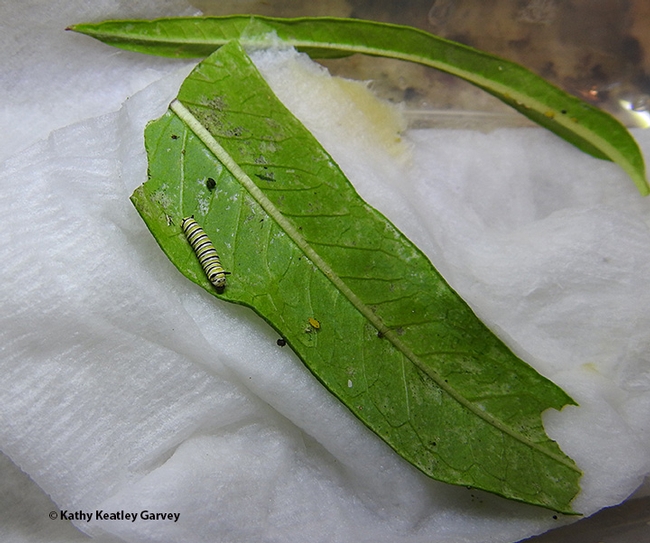
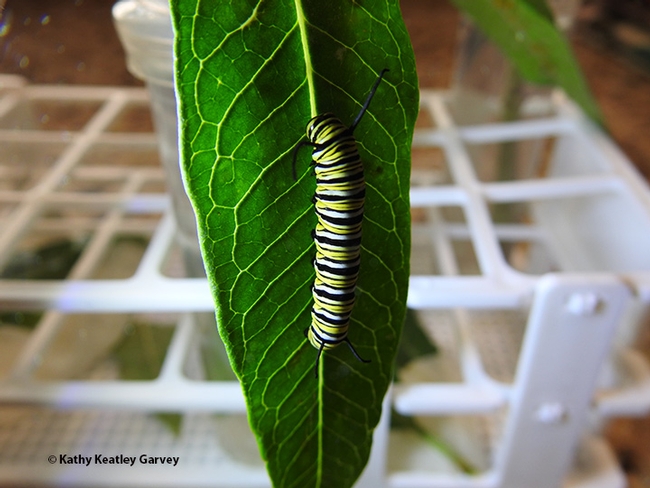
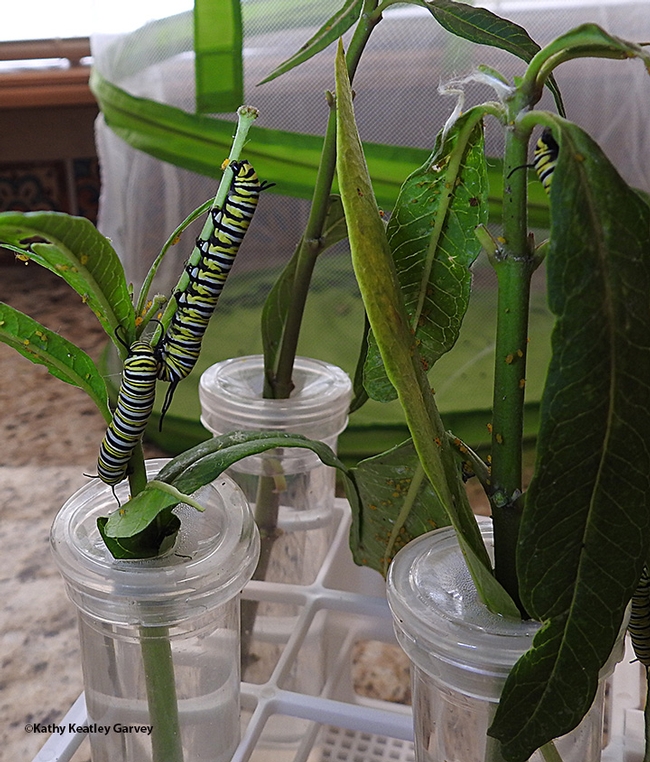
- Author: Kathy Keatley Garvey
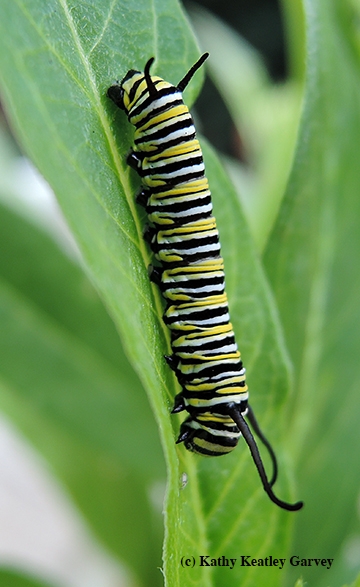
We walked into our little pollinator garden in Vacaville, Calif., this afternoon to cut a few tropical milkweed stems to feed the indoor caterpillars, and there, hidden beneath a leaf, was a tiny caterpillar.
Well, hello, there! Aren't you a little late? The monarchs have been overwintering along coastal California for a couple of months. Your parents did not get the memo.
This uncharacteristic weather we're having--autumn temperatures soaring into the 70s here in recent weeks--means the milkweed is still growing and the caterpillars are, too.
We've pruned all of the tropical milkweed down to the ground except for one plant that's still flowering. We're keeping it. Food is scarce for the honey bees, syrphid flies and other pollinators.
Meanwhile, Tiny Caterpillar is a new addition to our indoor habitat. Ours is just a small-scale conservation project of rearing and releasing monarchs to help boost the declining monarch population. So far this season, our total is 54. That's 54 that may have been eaten by birds or consumed inside-and-out by parasitoids such as the tachinid flies, which lay their eggs inside the caterpillars or chrysalids. Overall, about 2 or 3 percent of the monarchs make it all the way through their life cycle, from egg to caterpillar to chrysalis to adult, scientists estimate.
Here are the basics of how we rear them, but all Monarch Moms and Monarch Dads do it differently.
- Grow milkweed species, the host plant of the monarchs. We have four different species in our pollinator garden:
--Asclepias fascicularis, narrowleafed milkweed
--Asclepias speciosa, broadleaf milkweed
--Asclepias tuberosa, a Midwest favorite
--Asclepias curassavica, tropical milkweed - In addition to milkweed, plant other nectar-producing plants for your monarchs and other pollinators. The monarch favorites, at least in our yard, include Mexican sunflower (Tithonia), an annual that grows here from April through November (in fact it's still blooming), butterfly bush (Buddleia), and Lantana.
- When you see caterpillars on the milkweed, you'll need to protect them from predators, such as birds, tachinid flies and wasps by bringing them indoors. Add water to a heavy, narrow-necked, flat-bottomed bottle (we use Patron tequila bottles, compliments of our friends). Tuck the milkweed stems, with the 'cats still on the stems, in the tequila bottle. Then place the bottle in a meshed, zippered butterfly habitat, such as the ones from the Bohart Museum of Entomology. You can also buy meshed, zippered laundry bags from stores.
- Be sure to keep the milkweed fresh. Mist it lightly, and add new milkweed daily. Clean the frass from the bottom of the habitat.
- Watch caterpillars eat their fill and then pupate. You'll see the jade-green chrysalids, rimmed in gold, hanging from the top of the habitat.
- When the monarchs eclose, wait for their wings to dry before releasing them. We usually release them after four or five hours--if it's not cold or rainy. Food? They usually won't eat for 24 hours. If the weather is inclement and we can't release them right away, we feed them. We dip a cotton ball into a mixture of honey and water, and place it on a tray, along with a fresh flower or a slice of fruit, such as cantaloupe or watermelon. Some folks feed them a sugar and water mixture. Some use sports drinks such as Gatorade. Mona Miller, administrator of the Facebook page, Raising Butterflies and Moths for Conservation, tells how to feed monarchs on her YouTube channel. She uses 2 tablespoons of water (heated) and 1/2 teaspoon of raw organic honey (more amino acids and protein). She cools the mixture and places in a colorful cap lid (yellow, red, orange).
- When it's time to release a monarch, we just unzip the container. Sometimes we gently cradle the monarch, and then open our hands and watch it go. Some monarchs take off immediately. Others linger on our hands or head for a nearby plant.
- After you release each batch of monarchs, clean the container with soapy water and a little bleach.
Some excellent resources to get you started and keep you going:
- Xerces Society: Monarchs for Conservation and Project Milkweed
- The Beautiful Monarch, Facebook page administered by Holli Webb Hearn
- Raising Butterflies and Moths for Conservation, Facebook page administered by Mona Miller
